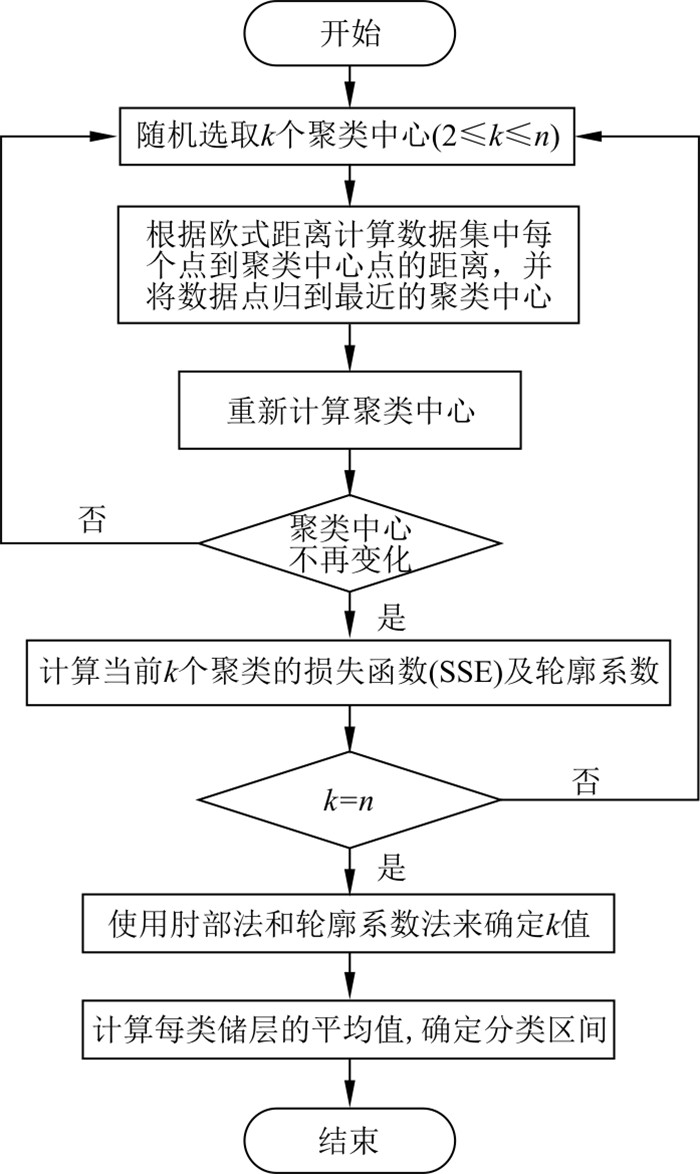Multiparameter reservoir evaluation method based on unsupervised learning: A case study of the reef beach reservoir of the Lower Triassic Feixianguan Formation in the Pubaoshan area
-
摘要:
四川盆地东北部蒲包山地区下三叠统飞仙关组礁滩储层的形成与发育是地质历史时期综合作用的结果, 因此储层评价时仅使用单一因素难免会产生偏差。采用k-means聚类分析和主成分分析相结合的方法对研究区储层进行了分类与评价。研究结果表明: 在已知蒲包山地区下三叠统飞仙关组礁滩储层的白云岩厚度、平均孔隙度以及储层有效厚度3种不同影响因素平面图的前提下, 对不同平面进行等大网格化, 提取不同影响因素的储层特征数据, 结合使用肘部法和轮廓法对储层特征数据进行分析并将储层划分成4种发育类型, 然后应用k-means聚类分析方法对已知的数据点进行类别属性分配; 使用主成分分析对不同储层特征数据进行降维处理形成一个新的综合参数, 参数贡献率达0.882, 按k-means的分类结果, 计算4种储层不同类型主成分分析综合参数的均值, 分别为0.404, 0.640, 0.716, 作为储层评价分区的分界点。最终使用此种量化的方法将研究区不同特征平面图合理融合在一起, 形成储层综合评价图。研究结果可有效地对研究区储层进行分类评价及有利勘探区预测。
Abstract:Objective The formation and development of the reef-shoal reservoirs in the Lower Triassic Feixianguan Formation in the Pobaoshan area are the result of the comprehensive action of the geological historical period. Therefore, only using a single factor in reservoir evaluation will inevitably lead to deviations.
Methods The k-means cluster analysis method and principal component analysis method were used to classify and evaluate the reservoir in the study area.
Results The results show that: On the premise that three different influencing factors of dolomite thickness, average porosity and effective reservoir thickness of the Lower Triassic Feixianguan Formation reef-shoal reservoir in the Pubaoshan area are known, gridding different planes to extract reservoir characteristic data of different influencing factors. The combined elbow method and contour method are used to analyze reservoir characteristic data and divide the reservoir into 4 development types. Then k-means cluster analysis method is applied to assign class attributes to the known data points. Using principal component analysis to reduce the dimensionality of different reservoir characteristic data to form a new comprehensive parameter. The parameter contribution rate can reach 0.882. According to the classification results of k-means, the mean values of the comprehensive parameters of different types of principal component analysis of the four reservoirs were calculated, which were 0.404, 0.640 and 0.716, respectively, as the demarcation point of the reservoir evaluation zone. Finally, this quantitative method is used to reasonably integrate the different characteristic plans of the study area to form a comprehensive evaluation map of the reservoir.
Conclusion The research results can effectively classify and evaluate the reservoir in the study area and predict favorable exploration areas.
-
表 1 研究区飞仙关组储层储集空间类型统计
Table 1. Statistics of reservoir space types of the Feixianguan Formation in the study area
空隙类型 特征 类 亚类 孔隙 粒间溶孔 鲕粒、砾屑或砂屑之间形成的孔隙,多被溶蚀扩大,常见于颗粒云岩、鲕粒灰岩中 粒内溶孔 颗粒内部被选择性地部分溶解而形成的孔隙,溶蚀孔隙形态不规则,部分被方解石、白云石充填,但留有部分的残余次生孔隙存在,孔隙直径小于颗粒直径,常见于颗粒云岩、鲕粒灰岩中 晶间溶孔 白云石或方解石晶体之间被溶蚀扩大的孔隙,常见于细粉晶云岩、中细晶云岩、残余鲕粒云岩中 晶间孔 晶粒云岩或晶粒灰岩中由晶体相互支撑形成的原生孔隙或晶间隙,呈三角形或多边形状,一般随着晶粒粒径的增大而增大,常见于晶粒云岩、晶粒灰岩中 铸模孔 鲕粒、砂屑或生物(屑)被全部溶蚀而形成的孔隙,颗粒的外部形态、大小保存较好,一般呈圆形至次圆形,基本无充填, 常见于残余鲕粒云岩或溶孔鲕粒灰岩中 非组构选择性溶孔 非组构选择性溶蚀岩石所形成的孔隙,可见于各类岩石 洞 溶洞 孔隙直径大于2mm的溶蚀孔,可见于各类岩石 裂缝 构造缝 由于切割力度不同而形成具多种形状的立缝、斜缝、网缝等,可见于各类岩石 构造溶蚀缝 沿构造缝扩溶而形成,无沥青充填,以泥细粉晶灰岩、云岩为主,粒屑云岩为辅 成岩缝 多充填泥质、沥青,见硅质充填,可见于各类岩石 表 2 主成分分析数据指标
Table 2. Data indicators of principal component analysis
协方差矩阵参数 第一主成分 第二主成分 第三主成分 特征值 0.219 3 0.020 5 0.008 8 贡献率 0.882 0 0.082 5 0.035 5 特征向量 0.388 4 0.875 3 0.288 2 0.666 2 -0.050 7 -0.744 0 0.636 6 -0.481 0 0.602 8 -
[1] 汪少勇, 李建忠, 郭秋麟, 等. 层次分析法在致密油有利区优选中的应用: 以川中侏罗系大安寨段为例[J]. 地球科学进展, 2015, 30(6): 715-723. https://www.cnki.com.cn/Article/CJFDTOTAL-DXJZ201506012.htmWang S Y, Li J Z, Guo Q L, et al. Application of AHP method to favorable area optimization for tight oil: A case study in Daanzhai Formation, Jurassic, central of the Sichuan Basin[J]. Advances in Earth Science, 2015, 30(6): 715-723(in Chinese with English abstract). https://www.cnki.com.cn/Article/CJFDTOTAL-DXJZ201506012.htm [2] 李阳, 代宗仰, 黄蕾, 等. 叠合概率法在碳酸盐岩储层评价中的应用: 以辽河坳陷西部凹陷高升地区沙四段为例[J]. 中国石油勘探, 2019, 24(3): 361-368. doi: 10.3969/j.issn.1672-7703.2019.03.009Li Y, Dai Z Y, Huang L, et al. Application of overlapping probability method in carbonate reservoir evaluation: A case study on 4th Member of Shahejie Formation in Gaosheng area of Western Sag, Liaohe Depression[J]. China Petroleum Exploration, 2019, 24(3): 361-368(in Chinese with English abstract). doi: 10.3969/j.issn.1672-7703.2019.03.009 [3] 冯子齐. 鄂尔多斯盆地东南部山西组海陆过渡相页岩储层特征与评价[D]. 北京: 中国地质大学(北京), 2014.Feng Z Q. Characteristics and evaluation of the organic-rich shale of Shanxi Formation, southeast in Ordos Basin[D]. Beijing: China University of Geosciences (Beijing), 2014(in Chinese with English abstract). [4] 刘凯, 石万忠, 王任, 等. 鄂尔多斯盆地杭锦旗地区盒1段致密砂岩孔隙结构分形特征及其与储层物性的关系[J]. 地质科技通报, 2021, 40(1): 57-68. doi: 10.19509/j.cnki.dzkq.2021.0102Liu K, Shi W Z, Wang R, et al. Pore structure fractal characteristics and its relationship with reservoir properties of the First Member of Lower Shihezi Formation tight sandstone in Hangjinqi area, Ordos Basin[J]. Bulletin of Geological Science and Technology, 2021, 40(1): 57-68(in Chinese with English abstract). doi: 10.19509/j.cnki.dzkq.2021.0102 [5] 陈林, 陈孝红, 张保民, 等. 鄂西宜昌地区五峰组-龙马溪组页岩储层特征及其脆性评价[J]. 地质科技通报, 2020, 39(2): 54-61. doi: 10.19509/j.cnki.dzkq.2020.0206Chen L, Chen X H, Zhang B M, et al. Reservoir characteristics and brittleness evaluation of Wufeng Formation-Longmaxi Formation shale in Yichang area, western Hubei Province[J]. Bulletin of Geological Science and Technology, 2020, 39(2): 54-61(in Chinese with English abstract). doi: 10.19509/j.cnki.dzkq.2020.0206 [6] 朱伟, 顾韶秋, 曹子剑, 等. 基于模糊数学的滨里海盆地东南油气储层评价[J]. 石油与天然气地质, 2013, 34(3): 357-362. https://www.cnki.com.cn/Article/CJFDTOTAL-SYYT201303016.htmZhu W, Gu S Q, Cao Z J, et al. Fuzzy mathematics-based reservoir evaluation in the southeastern Pre-Caspian Basin[J]. Oil & Gas Geology, 2013, 34(3): 357-362(in Chinese with English abstract). https://www.cnki.com.cn/Article/CJFDTOTAL-SYYT201303016.htm [7] 姬新元, 王红亮, 徐小龙, 等. 基于模糊数学理论的储层评价: 以鄂尔多斯盆地富黄地区延长组长9油层为例[J]. 科学技术与工程, 2019, 19(20): 49-55. https://www.cnki.com.cn/Article/CJFDTOTAL-KXJS201920007.htmJi X Y, Wang H L, Xu X L, et al. Evaluation of reservoirs based on fuzzy mathematics: A case study from Chang 9 Formation in Fuhuang area, Ordos Basin[J]. Science Technology and Engineering, 2019, 19(20): 49-55(in Chinese with English abstract). https://www.cnki.com.cn/Article/CJFDTOTAL-KXJS201920007.htm [8] 郑璇, 赵军龙, 许建涛, 等. 神经网络技术在储层分类评价中的应用[J]. 陕西煤炭, 2013, 32(2): 63-66. https://www.cnki.com.cn/Article/CJFDTOTAL-SXMJ201302025.htmZheng X, Zhao J L, Xu J T, et al. Application of neural network technology in classification and evaluation of reservoirs[J]. Shaanxi Coal, 2013, 32(2): 63-66(in Chinese with English abstract). https://www.cnki.com.cn/Article/CJFDTOTAL-SXMJ201302025.htm [9] 贺亚维, 张荣军, 郭永宏. 延川地区储层特征及综合评价[J]. 西安科技大学学报, 2019, 39(5): 811-818. https://www.cnki.com.cn/Article/CJFDTOTAL-XKXB201905011.htmHe Y W, Zhang R J, Guo Y H. Geological characteristics and comprehensive evaluation of reservoir in Yanchuan area[J]. Journal of Xi'an University of Science and Technology, 2019, 39(5): 811-818(in Chinese with English abstract). https://www.cnki.com.cn/Article/CJFDTOTAL-XKXB201905011.htm [10] 邹妞妞, 庞雷, 史基安, 等. 准噶尔盆地西北缘玛北地区百口泉组砂砾岩储层评价[J]. 天然气地球科学, 2015, 26(增刊2): 63-72. https://www.cnki.com.cn/Article/CJFDTOTAL-TDKX2015S2007.htmZou N N, Pan L, Shi J A, et al. Reservoir evaluation of glutenite body of Baikouquan Formation in Mabei area, NW Junggar Basin[J]. Natural Gas Geoscience, 2015, 26(S2): 63-72(in Chinese with English abstract). https://www.cnki.com.cn/Article/CJFDTOTAL-TDKX2015S2007.htm [11] 任培罡, 夏存银, 李媛, 等. 自组织神经网络在测井储层评价中的应用[J]. 地质科技情报, 2010, 29(3): 114-118. https://www.cnki.com.cn/Article/CJFDTOTAL-DZKQ201003019.htmRen P G, Xia C Y, Li Y, et al. Application of self-organizing neural network to logging reservoir evaluation[J]. Geological Science and Technology Information, 2010, 29(3): 114-118(in Chinese with English abstract). https://www.cnki.com.cn/Article/CJFDTOTAL-DZKQ201003019.htm [12] 周林, 刘皓天, 周坤, 等. 致密砂岩储层"甜点"识别及评价方法[J]. 地质科技通报, 2020, 39(4): 165-173. doi: 10.19509/j.cnki.dzkq.2020.0420Zhou L, Liu H T, Zhou K, et al. "Sweet spot" identification and evaluation of tight sandstone reservoir[J]. Bulletin of Geological Science and Technology, 2020, 39(4): 165-173(in Chinese with English abstract). doi: 10.19509/j.cnki.dzkq.2020.0420 [13] 王千, 王成, 冯振元, 等. k-means聚类算法研究综述[J]. 电子设计工程, 2012, 20(7): 21-24. https://www.cnki.com.cn/Article/CJFDTOTAL-GWDZ201207009.htmWang Q, Wang C, Feng Z Y, et al. Review of k-means clustering algorithm[J]. Electronic Design Engineering, 2012, 20(7): 21-24(in Chinese with English abstract). https://www.cnki.com.cn/Article/CJFDTOTAL-GWDZ201207009.htm [14] Kapageridis I K. Variable lag variography using k-means clustering[J]. Computers and Geosciences, 2015, 85: 49-63. [15] 姜艳娇, 孙建孟, 高建申, 等. X区块低孔渗气藏储层特征及分类评价研究[J]. 科学技术与工程, 2017, 17(10): 164-172. https://www.cnki.com.cn/Article/CJFDTOTAL-KXJS201710028.htmJiang Y J, Sun J M, Gao J S, et al. Study on reservoir characteristics and classification evaluation in low porosity and low permeability gas reservoir of X Block[J]. Science Technology and Engineering, 2017, 17(10): 164-172(in Chinese with English abstract). https://www.cnki.com.cn/Article/CJFDTOTAL-KXJS201710028.htm [16] 张建萍, 刘希玉. 基于聚类分析的K-means算法研究及应用[J]. 计算机应用研究, 2007, 24(5): 166-168. https://www.cnki.com.cn/Article/CJFDTOTAL-JSYJ200705050.htmZhang J P, Liu X Y. Application in cluster's analysis is analyzed in children development period[J]. Application Research of Computers, 2007, 24(5): 166-168(in Chinese with English abstract). https://www.cnki.com.cn/Article/CJFDTOTAL-JSYJ200705050.htm [17] 段友祥, 柳璠, 孙歧峰, 等. 基于相带划分的孔隙度预测[J]. 南京大学学报: 自然科学版, 2019, 55(6): 934-941. https://www.cnki.com.cn/Article/CJFDTOTAL-NJDZ201906006.htmDuan Y X, Liu P, Sun Q F, et al. Porosity prediction based on sedimentary facies[J]. Journal of Nanjing University: Natural Science Edition, 2019, 55(6): 934-941(in Chinese with English abstract). https://www.cnki.com.cn/Article/CJFDTOTAL-NJDZ201906006.htm [18] Goutte C, Toft P, Rostrup E, et al. On clustering fMRI time series[J]. Neuro Image, 1999, 9(3): 298-310. [19] Ketchen D J, Shook C L. The application of cluster analysis in strategic management research: An analysis and critique[J]. Strategic Management Journal, 1996, 17(6): 441-458. [20] de Amorim R C, Hennig C. Recovering the number of clusters in data sets with noise features using feature rescaling factors[J]. Information Sciences, 2015, 324: 126-145. [21] Forghani Y. Comment on "DSKmeans: A new k-means-type approach to discriminative subspace clustering" by X. Huang et al. Knowledge-based systems, Vol. 70, pp. 293-300, 2014[J]. Knowledge-Based Systems, 2016, 118: 1-3. [22] Gündoĝdu Y, Karabaĝh P, Alptekin H, et al. Comparison of performances of Principal Component Analysis (PCA) and Factor Analysis (FA) methods on the identification of cancerous and healthy colon tissues[J]. International Journal of Mass Spectrometry, 2019, 445: 116204. [23] Aversano G, Parra-Alvarez J C, Isaac B J, et al. PCA and Kriging for the efficient exploration of consistency regions in Uncertainty Quantification[J]. Proceedings of the Combustion Institute, 2019, 37(4): 4461-4469. [24] 彭仕宓, 熊琦华, 王才经, 等. 储层综合评价的主成分分析方法[J]. 石油学报, 1994(增刊1): 187-194. https://www.cnki.com.cn/Article/CJFDTOTAL-SYXB4S1.023.htmPeng S M, Xiong Q H, Wang C J, et al. A method of principle component analysis in comprehensive reservoir evaluation[J]. Acta Petrolei Sinica, 1994(S1): 187-194(in Chinese with English abstract). https://www.cnki.com.cn/Article/CJFDTOTAL-SYXB4S1.023.htm -





 下载:
下载:










